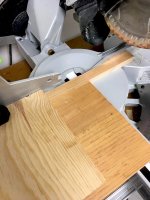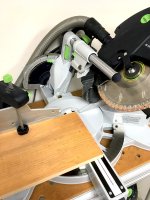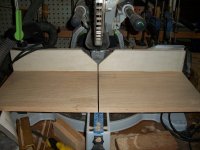I don't make a lot of bevel cuts, but I'm making a box with 8" wide boards that require a 45 degree bevel cut. Making a few practice cuts resulted in the cut-off piece going behind the blade and that piece shattered and flew all over the place and the last part of the cut was rough and not suitable for doing miters. I did keep the blade going full speed all the way through the cut and moved the blade at a slow pace. I then placed a piece of wood between the work piece and the fence so that the cut off piece could not move behind the blade. The cut was better, but the cut-off piece still had some "kick back" just not as severe as without the sacrificial piece of wood. Near the end of the cut with either method I can feel the saw slow and maybe bind in the wood, not sure how to describe it other than it slows and feels like it is going to kickback.
I can do this cut with 4" stock without the same kickback, so maybe it is related to the width of the piece or maybe I should move this cut to the table saw. Anyway looking for feedback about how others deal with this. I have read a few of the previous threads about kickback on the kapex.
[attachimg=1]
I can do this cut with 4" stock without the same kickback, so maybe it is related to the width of the piece or maybe I should move this cut to the table saw. Anyway looking for feedback about how others deal with this. I have read a few of the previous threads about kickback on the kapex.
[attachimg=1]



